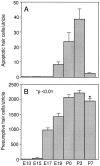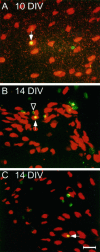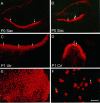Analysis of rat vestibular hair cell development and regeneration using calretinin as an early marker
- PMID: 9334402
- PMCID: PMC6573764
- DOI: 10.1523/JNEUROSCI.17-21-08270.1997
Analysis of rat vestibular hair cell development and regeneration using calretinin as an early marker
Abstract
Despite increased interest in inner ear hair cell regeneration, it is still unclear what exact mechanisms underlie hair cell regeneration in mammals because of our limited understanding of hair cell development and the lack of specific hair cell markers. In this report, we studied hair cell development using immunohistochemistry on sections prepared from embryonic day (E) 13 to postnatal day 7 rat inner ear tissues. Of many epithelial, neuronal, and glial markers, we found that calcium-binding protein antibodies recognizing calretinin, calmodulin, or parvalbumin labeled immature hair cells in rat vestibular end organs. In particular, calretinin antiserum labeled the initial differentiating hair cells at E15, a stage immediately after the terminal mitosis of hair cell progenitors. The selective immunoreactivity of postmitotic presumptive hair cells, but not supporting cells or peripheral epithelial cells, was confirmed in utricular epithelial sheet cultures. Double labeling with calretinin and bromodeoxyuridine antibodies in long-term cultures showed that only a few mitotic utricular supporting cells became calretinin positive. Thus, although proliferation-mediated regeneration of new hair cells might directly contribute to hair cell regeneration in rat utricles after injury, it is very limited. In addition, double labeling with calretinin and terminal deoxynucleotidyl transferase-mediated dUTP nick end labeling (TUNEL) revealed that differentiated hair cells underwent apoptosis during normal development at late embryonic and early postnatal stages in vivo and in vitro. Therefore, these experiments lay the groundwork for the time course of differentiation, regeneration, and apoptosis of mammalian vestibular hair cells. This work also suggests that calcium-binding proteins are useful markers for studies on inner ear hair cell differentiation and regeneration.
Figures









Similar articles
-
Establishment of conditionally immortalized rat utricular epithelial cell lines using a retrovirus-mediated gene transfer technique.Hear Res. 1998 Mar;117(1-2):13-23. doi: 10.1016/s0378-5955(97)00205-0. Hear Res. 1998. PMID: 9557974
-
Calbindin and parvalbumin are early markers of non-mitotically regenerating hair cells in the bullfrog vestibular otolith organs.Int J Dev Neurosci. 1997 Jul;15(4-5):417-32. doi: 10.1016/s0736-5748(96)00101-3. Int J Dev Neurosci. 1997. PMID: 9263023
-
Calretinin immunoreactivity in chinchilla and guinea pig vestibular end organs characterizes the calyx unit subpopulation.Exp Brain Res. 1992;89(1):105-8. doi: 10.1007/BF00229006. Exp Brain Res. 1992. PMID: 1601088
-
Ongoing cell death and immune influences on regeneration in the vestibular sensory organs.Ann N Y Acad Sci. 2001 Oct;942:34-45. doi: 10.1111/j.1749-6632.2001.tb03733.x. Ann N Y Acad Sci. 2001. PMID: 11710476 Review.
-
Development and evolution of the vestibular sensory apparatus of the mammalian ear.J Vestib Res. 2005;15(5-6):225-41. J Vestib Res. 2005. PMID: 16614470 Free PMC article. Review.
Cited by
-
Growth factor treatment enhances vestibular hair cell renewal and results in improved vestibular function.Proc Natl Acad Sci U S A. 2001 May 8;98(10):5886-91. doi: 10.1073/pnas.101120898. Epub 2001 May 1. Proc Natl Acad Sci U S A. 2001. PMID: 11331776 Free PMC article.
-
Developmental expression of calretinin in the mouse cochlea.Eur J Histochem. 2024 Nov 6;68(4):4137. doi: 10.4081/ejh.2024.4137. Eur J Histochem. 2024. PMID: 39508782 Free PMC article.
-
Hedgehog signaling regulates sensory cell formation and auditory function in mice and humans.J Neurosci. 2008 Jul 16;28(29):7350-8. doi: 10.1523/JNEUROSCI.0312-08.2008. J Neurosci. 2008. PMID: 18632939 Free PMC article.
-
Blocking caspase-3-dependent pathway preserves hair cells from salicylate-induced apoptosis in the guinea pig cochlea.Mol Cell Biochem. 2011 Jul;353(1-2):291-303. doi: 10.1007/s11010-011-0798-1. Epub 2011 Apr 19. Mol Cell Biochem. 2011. PMID: 21503676
-
Sox2 and JAGGED1 expression in normal and drug-damaged adult mouse inner ear.J Assoc Res Otolaryngol. 2008 Mar;9(1):65-89. doi: 10.1007/s10162-007-0106-7. Epub 2007 Dec 22. J Assoc Res Otolaryngol. 2008. PMID: 18157569 Free PMC article.
References
-
- Adler HJ, Raphael Y. New hair cells arise from supporting cell conversion in the acoustically damaged chick inner ear. Neurosci Lett. 1996;205:17–20. - PubMed
-
- Baimbridge KG, Celio MR, Roger JH. Calcium-binding proteins in the nervous system. Trends Neurosci. 1992;15:303–309. - PubMed
-
- Baird RA, Torres MA, Schuff NR. Hair cell regeneration in the bullfrog vestibular otolith organs following aminoglycoside toxicity. Hear Res. 1993;65:164–174. - PubMed
-
- Baird RA, Steyger PS, Schuff NR. Mitotic and nonmitotic hair cell regeneration in the bullfrog vestibular otolith organs. Ann NY Acad Sci. 1996;781:59–70. - PubMed
MeSH terms
Substances
LinkOut - more resources
Full Text Sources
Other Literature Sources
